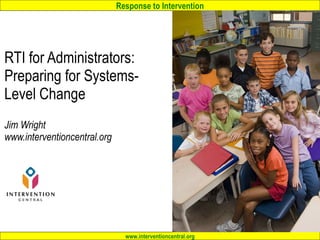
Admin Overview Red Creek Dec 09
- 1. RTI for Administrators: Preparing for Systems-Level Change Jim Wright www.interventioncentral.org
- 3. RTI Institute: Administrator Strand: Workshop Agenda RTI Overview Systems Change & Reluctant Teachers Web Resources to Support RTI Implementation
- 5. RTI ‘Pyramid of Interventions’ Tier 1 Tier 2 Tier 3 Tier 1: Universal interventions. Available to all students in a classroom or school. Can consist of whole-group or individual strategies or supports. Tier 2 Individualized interventions. Subset of students receive interventions targeting specific needs. Tier 3: Intensive interventions. Students who are ‘non-responders’ to Tiers I & II may be eligible for special education services, intensive interventions.
- 10. RTI Interventions: Standard-Treatment vs. Problem-Solving There are two different vehicles that schools can use to deliver RTI interventions: Standard-Protocol (Standalone Intervention). Programs based on scientifically valid instructional practices (‘standard protocol’) are created to address frequent student referral concerns. These services are provided outside of the classroom. A middle school, for example, may set up a structured math-tutoring program staffed by adult volunteer tutors to provide assistance to students with limited math skills. Students referred for a Tier II math intervention would be placed in this tutoring program. An advantage of the standard-protocol approach is that it is efficient and consistent: large numbers of students can be put into these group interventions to receive a highly standardized intervention. However, standard group intervention protocols often cannot be individualized easily to accommodate a specific student’s unique needs. Problem-solving (Classroom-Based Intervention). Individualized research-based interventions match the profile of a particular student’s strengths and limitations. The classroom teacher often has a large role in carrying out these interventions. A plus of the problem-solving approach is that the intervention can be customized to the student’s needs. However, developing intervention plans for individual students can be time-consuming.
- 14. Scheduling Elementary Tier 2 Interventions Source: Burns, M. K., & Gibbons, K. A. (2008). Implementing response-to-intervention in elementary and secondary schools: Procedures to assure scientific-based practices. New York: Routledge. Classroom 1 Classroom 2 Classroom 3 Grade K Classroom 1 Classroom 2 Classroom 3 Grade 1 Classroom 1 Classroom 2 Classroom 3 Grade 2 Classroom 1 Classroom 2 Classroom 3 Grade 3 Classroom 1 Classroom 2 Classroom 3 Grade 4 Classroom 1 Classroom 2 Classroom 3 Grade 5 Anyplace Elementary School: RTI Daily Schedule Option 3: ‘Floating RTI’:Gradewide Shared Schedule . Each grade has a scheduled RTI time across classrooms. No two grades share the same RTI time. Advantages are that outside providers can move from grade to grade providing push-in or pull-out services and that students can be grouped by need across different teachers within the grade. 9:00-9:30 9:45-10:15 10:30-11:00 12:30-1:00 1:15-1:45 2:00-2:30
- 19. Target Student ‘ Dual-Discrepancy’: RTI Model of Learning Disability (Fuchs 2003) Discrepancy 1: Skill Gap (Current Performance Level) Avg Classroom Academic Performance Level Discrepancy 2: Gap in Rate of Learning (‘Slope of Improvement’)
- 20. Implementing Response to Intervention in Secondary Schools: Key Challenges to Changing a System Jim Wright www.interventioncentral.org
- 26. Engaging the Reluctant Teacher: Seven Reasons Why Instructors May Be Reluctant to Implement Classroom (Tier 1) RTI Interventions Jim Wright www.interventioncentral.org
- 31. ‘ Scaling Up’: Four Stages of RTI Development Jim Wright www.interventioncentral.org
- 40. Ideas to Build Teacher Understanding and Support for RTI Jim Wright www.interventioncentral.org
- 49. NYSED RTI Guidance Memo: April 2008
- 51. “ The Regents policy framework for RtI: Defines RtI to minimally include: Appropriate instruction delivered to all students in the general education class by qualified personnel. Appropriate instruction in reading means scientific research-based reading programs that include explicit and systematic instruction in phonemic awareness, phonics, vocabulary development, reading fluency (including oral reading skills) and reading comprehension strategies. Screenings applied to all students in the class to identify those students who are not making academic progress at expected rates.”
- 52. “ Instruction matched to student need with increasingly intensive levels of targeted intervention and instruction for students who do not make satisfactory progress in their levels of performance and/or in their rate of learning to meet age or grade level standards. Repeated assessments of student achievement which should include curriculum based measures to determine if interventions are resulting in student progress toward age or grade level standards. The application of information about the student’s response to intervention to make educational decisions about changes in goals, instruction and/or services and the decision to make a referral for special education programs and/or services.”
- 53. “ Written notification to the parents when the student requires an intervention beyond that provided to all students in the general education classroom that provides information about the: -amount and nature of student performance data that will be collected and the general education services that will be provided; -strategies for increasing the student’s rate of learning; and -parents’ right to request an evaluation for special education programs and/or services.”
- 54. “ The Regents policy framework for RtI: Defines RtI to minimally include: Requires each school district to establish a plan and policies for implementing school-wide approaches and prereferral interventions in order to remediate a student’s performance prior to referral for special education, which may include the RtI process as part of a district’s school-wide approach. The school district must select and define the specific structure and components of its RtI program, including, but not limited to the: -criteria for determining the levels of intervention to be provided to students, -types of interventions, amount and nature of student performance data to be collected, and -manner and frequency for progress monitoring.”
- 59. Building Teacher Capacity to Deliver Tier 1 Interventions: An 8-Step Checklist Jim Wright www.interventioncentral.org